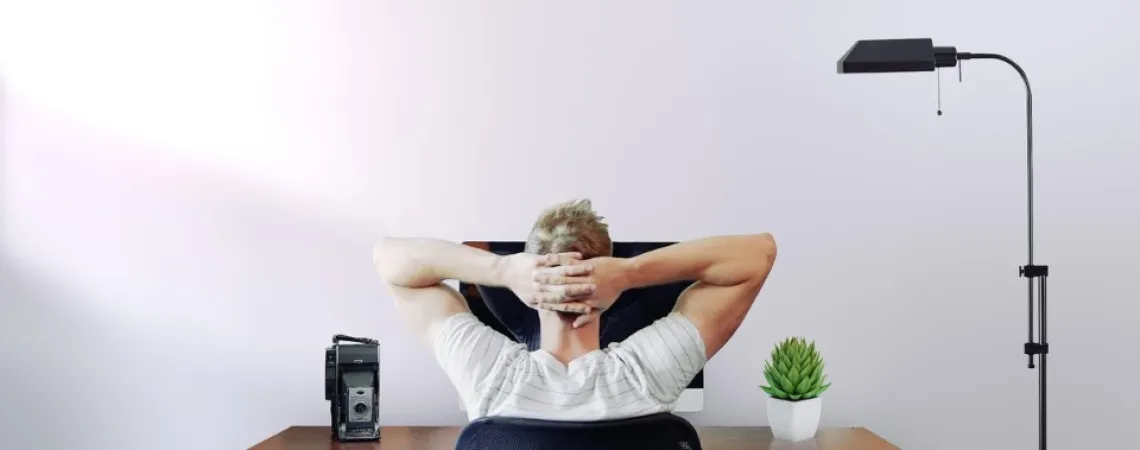
Muscle pain when Working From Home | Occupational Therapy
Article written in collaboration with Marie-Andrée B. Benoit, occupational therapist at the CMI Clinic
It has been two years since the pandemic sent us home to work. Even though companies are increasingly considering a return to the office, telecommuting is persistent and holds its own!
From an unprecedented situation that was thought to be temporary, a reality of our daily life has emerged. And yet, let's face it, some of us are as well prepared for this lifestyle as we were on day one...
Work from home: the new enemy of muscle pain (back, neck, wrists, arms, shoulders)
Two years after the beginning of the pandemic, it is not uncommon to note, during discussions with friends or colleagues, that the environment in which we work seven or eight hours a day is sometimes not very ergonomic!
The problem is that non-ergonomic working conditions (bad posture, bad habits, bad workstation etc...) often go hand in hand with muscular pain! Back pain, neck pain, wrist pain, all of our muscles can quickly become sore.
It is not for nothing that consultations for work-related pain have exploded over the past two years in occupational therapy.
Our mission is to give you all the tips you need to relieve or avoid muscle pain after your work day!
If you have pain related to your work environment, make an appointment with one of our occupational therapists. He or she can help relieve your pain and assist you in a sustainable return to work.
What are the causes of muscle pain in telecommuting?
When telecommuting, the onset of muscle pain can be related to a variety of factors. It could be a prolonged bad posture, a workstation that is not really ergonomic, or the absence of breaks during the work day.
Muscle pain can be a combination of these different factors. It may also be that certain personal weaknesses or job characteristics make you especially sensitive to certain postures.
Good habits to adopt when teleworking
An ergonomic environment
It may seem like you hear this word all the time, but an ergonomic environment is likely to reduce the risk of muscle pain.
What exactly is an ergonomic environment? First of all, avoid working on the kitchen table. It is important to have a real desk and an ergonomic chair. In short, tools that are adapted to your body and to the use you will make of them.
In addition, it is important that the chair be adjustable to fit the height of the desk, as well as your computer screen.
If your chair does not have lumbar support that conforms well to your lumbar curve, add a cushion in the small of your back.
This will prevent lower back pain. If you want to learn more about back pain, check out our guide.
In addition, your computer screen should be placed at eye level. This is not always easy, especially when you have a laptop. To remedy this, the purchase of a tablet to raise it and an external keyboard may be relevant.
The right posture to adopt
Whatever position you choose, the first thing to do is to change your position regularly and take breaks during the day.
Some advice can be given on the right posture to have. Your feet should be flat, or on a footrest to allow your thighs to be parallel to the ground.
As for your back, it must be well at the bottom of your chair. You should keep your back straight and avoid slouching as much as possible. If you want to learn more about back pain when telecommuting, check out our article.
Adjust your monitor to your eye level so you don't have to throw your head forward or look up/down constantly. Your neck will thank you!
The position of your elbows and wrists is also important to protect them from pain and potential injury (in the case of elbow or wrist tendonitis, or carpal tunnel syndrome). Your arms should therefore be close to the keyboard, supported and in a neutral position as much as possible.
An occupational therapy follow-up may be relevant if your posture is inadequate and this causes pain. The occupational therapist can analyze your environment and your posture and correct them, if necessary. Sometimes one change can lead to a chain of changes, so it may take a professional eye to make the right choices!
Good habits to adopt on a daily basis
You've probably noticed that telecommuting conditions are conducive to spending long hours sitting down, sometimes forgetting to take breaks? That's a bad habit to break!
You may not go to the office, but try as much as possible to keep a rhythm that comes close. For example, dress as if you were going out. This will put you in a good mood.
It is essential to take regular breaks, both for your body and your mind. You are not a robot!
Get up every hour or two and take five minutes to breathe and stretch your legs. Take the opportunity to stretch. Back, wrists, shoulders... your muscles will thank you!
Also, don't forget to stay hydrated. Drink water regularly.
At noon, don't forget to eat lunch! A full meal will give you the strength and energy you need to get through the day! Make sure you don't eat at your desk and move to another room, it won't hurt your spirit. Taking a walk can also be a good option.
Practice a sport activity during your day, to fight against sedentariness. This can be before you start, or after. Walking, swimming or meditation are among the recommendations.
How do you know if a pain is muscular?
Do you regularly experience pain in your lower back, spine or neck during your work day? These pains may be muscular, but it is difficult, if not impossible, to diagnose them on your own.
A consultation with a health professional will allow you to know exactly what causes your pain, whether it is muscular, nervous or articular.
Muscle pain and stiffness, fatigue and stress
Even if it is undeniable that a bad work station has a strong chance of creating muscular pains in workers, it should not be forgotten that fatigue and stress are as many risk factors for the appearance of neck, shoulder or back pains.
The absence of a break in the morning or of physical activity can increase a worker's stress, since he or she has no time to breathe and think about something other than work.
For these reasons, it is essential to stay on the move as much as possible. Use the time you save on public transportation for personal development! Take up yoga or meditation to release accumulated tension and stress.
Muscle aches, spasms or cramps, similar to those experienced after unusual physical exertion, can also occur in situations of stress or fatigue, or in the case of poor posture.
I have pain everywhere at the end of my day, how can I relieve and heal the pain, tension and muscle aches in my back naturally?
If you've just finished your day's work and you're experiencing headaches and back pain, start by stretching, gently.
The cat stretch has been proven to work. Sitting against a wall, place your hands on your knees and alternate between hollow back and round back. If this stretch gives you relief, repeat it several times. However, if your pain increases, do not repeat it.
You can also practice self-massage with a tennis ball to relieve tension accumulated during the day.
Lean against a wall and move the tennis ball along your back and then over the painful area.
When pain occurs, cold therapy can be effective. Apply it in short bursts. Once the inflammation subsides, you can then apply heat, unless the cold gives you more relief. Either way, wrap a towel around it, so as not to irritate or burn the skin.
If the pain persists after a few days, the most reasonable thing to do is to make an appointment with a health care professional. Occupational therapy is recommended to relieve work-related pain or injury.
What to do in case of and how to treat muscle pain?
Focus on occupational therapy
When faced with aches and pains related to our work environment, we should not bury our heads in the sand. We spend seven to eight hours a day at work.
If pain results from this and we ignore it, it could in some cases become disabling and affect our daily life in the long term. It could even prevent us from doing our job properly!
Don't panic though, good habits coupled with occupational therapy follow-up will help relieve your pain, prevent new ones and ensure that you can continue to work safely and sustainably!
Occupational therapy aims to restore an individual's functional abilities when they are affected by an injury, work-related or not. This is done by teaching exercises (stretching in particular), advice on good habits and the right posture to adopt when working at home.
In addition, occupational therapy also plays a preventive role to avoid developing new or pre-existing pain. This means that you can make an appointment as a preventive measure.
By analyzing your environment, the occupational therapist will be able to give you the necessary advice to practice safely.
If you are currently experiencing pain that you suspect is related to prolonged poor posture and/or a poor work environment, make an appointment directly with one of our occupational therapists.
He or she will take care of you so that you can continue your activities in a sustainable manner.






